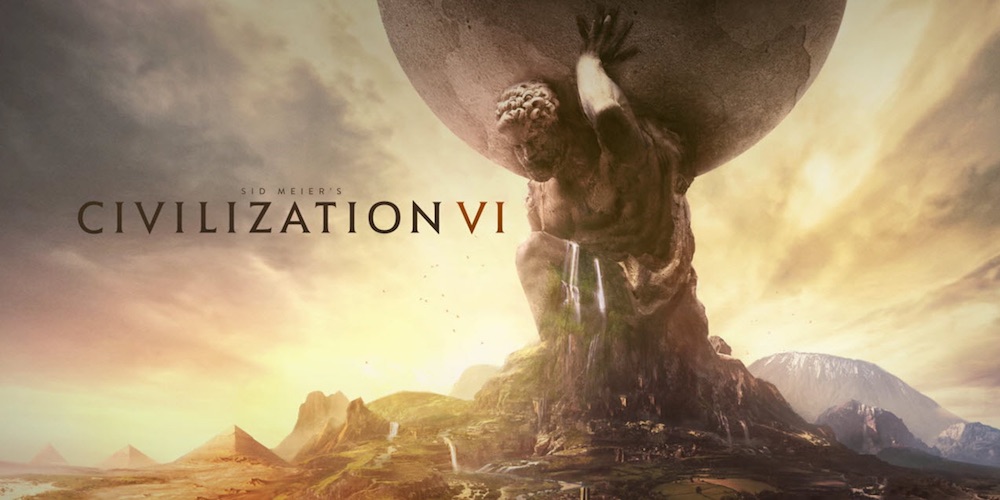
Glory to Nippon, most risen of the sunrise lands. Radiant are her borders, majestic are her fields, timeless is her charming attitude towards censorship, and her dedication to the true arts of war are legendary. Who knew that samurai were so good against artillery? Good thing Civ VI cleared that one up, otherwise I might have failed my next history exam. Although, if Nippon could do a bit better on the amenities front, maybe we could build Hakuba this time. And if the Spaniards could get off their literal high horses, that’d be great too. And who the hell invited the Nords?! WHY IS EVERYTHING ON FIRE!? QUICK, BUILD A NATIONAL PARK, THAT’LL SOLVE ALL OF OUR PROBLEMS!
…Yeah, I’m a fan of Civ VI. By this point, there’s a good chance you know what Civ has to offer. The 4X-grandfather egregia cum laude is something like a backup plan for any Steam library due to its ingenious design and hyper-aggressive Gandhi. You can lose yourself in ‘one more turn’ syndrome for days, and the latest instalment in the franchise doesn’t make leaving the house any easier. I stayed up til 3 am until I noticed the time, then I kept going, then I remembered I had uni. Then I kept going. It’s good. It’s exquisite.
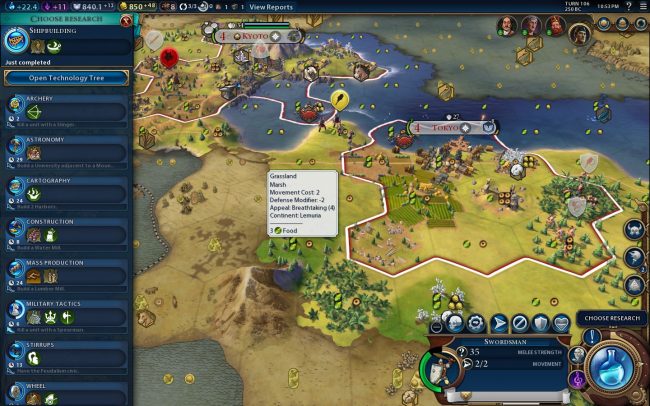
The core game is much the same as previous Civilisation games. You start with a warrior, a settler and a dream. You start venturing out into the unknown, encountering new cultures like yourself or city-states who just want to be involved, and build up your nation into the greatest society on the face of the planet. Then you nuke India before they can nuke you, start a new game and repeat the whole process until 2050. The move to hexes has stayed around from Civ V, but quite a lot has changed with how you interact with them.
While the core mechanics have remained largely unchanged from previous Civ titles, how you interact with hexes is far more flexible. Instead of only being able to build improvements on tiles, you can now create districts which act as specialist areas. By sacrificing the resources on any given tile, you can create a district which significantly improves food production, military strength, scientific speed, etc. To me, this is one of the best improvements in the game, adding far more emphasis on working the environment around you rather than making your city a super tile. Improvements still have their place, though, but creating them is more engaging than before.
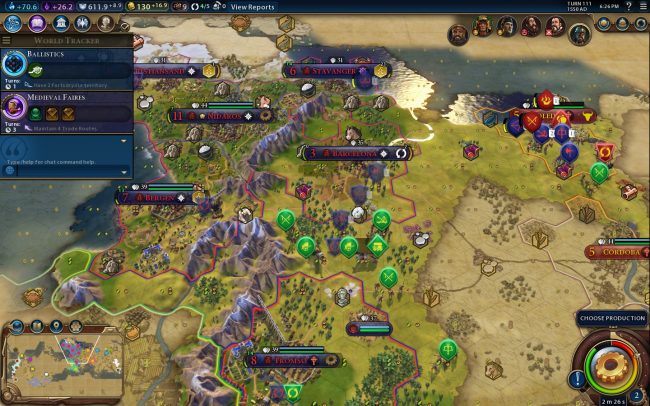
One of the problems with Civ V was that workers became meaningless automata in the late game. Now, they only have three uses, making them a lot more precious to use and relevant as a unit. Add to this that games are more expansive than before – which feels like the right direction to go – and you’ve got yourself one hell of an improvement to building improvements. The set-and-forget philosophy has been eliminated from almost every aspect of the game, and in doing so, everything feels more impactful.
Everything in Civ VI has immediate and visible effects, which is great when there are so many elements to the game. When you research a new tech, it will unlock something you can actively build or seek out. On top of that, each tech is accompanied by a ‘boost’ criterion, which reduces the amount of science required to research the tech by half upon fulfilling the criterion. Half seems a bit much to my liking, but the boost mechanic tends to reward specific playstyles more, which counteracts the OP-ness. Not everything is a perfect example of design, though, because the UI is just as frustrating as before.

To call the UI annoying would be a minor understatement. There have been plenty of improvements since Civ V, including streamlined design and iconography, but my god are there gaping flaws. You can’t scroll up because the top bar is in the way, diplomacy messages will pop up that add nothing to the game, and don’t get me started on the occasionally-auto-positioning camera. The game’s biggest flaw is the system you use to play the game with, which is manageable but no less aggravating when you just want to do one particular thing. Still, the game itself has a lot to love, not least the new visual design.
At first, the new look didn’t sell me, but after some time with the game, the visuals have grown on me. The map is drawn like an actual map, complete with faux Kraken and compass, and gets coloured in when units are present in the area. Once they leave, an imprint is left that looks vaguely hand drawn, which is surprisingly cool in action. The game goes for a more cartoony look but doesn’t go too far so as to forget what reality was. The clutter of previous games has been replaced with clearer representations that still make sense. There’s not much to dislike about the presentation of the game, and the same applies to the game as a whole.

Hell, just one more paragraph. Let’s talk about amenities, the new version of happiness that is managed on a city-by-city basis. I am a big fan of this mechanic, in much the same way that metalheads are big fans of Norway (which, coincidentally, I am!). Instead of shoving happiness-inducers in random cities, you have to make sure your settlement can accommodate the wants of more people. If you don’t, the population won’t increase, and you’ll be left with a weak city without a point. Amenities feel more concrete than happiness ever did, which helps the impactfulness of the game.
… Just one more paragraph. When it comes to keeping the game impactful, the new civics system works wonderfully. Instead of locking you into a civics tree, you can choose certain governments to gain buffs and equip individual policy cards. For example, Merchant Republic allows you to have more trade routes, a discount on gold purchases, and equip one military, two economic, one diplomatic and two wild cards. These cards might make units cheaper, increase production, etc. You can change these every time you research a civic, or you can spend gold to change them (or your whole government) on the fly, but the system feels much more engaging and flexible than Civ V’s civic system.
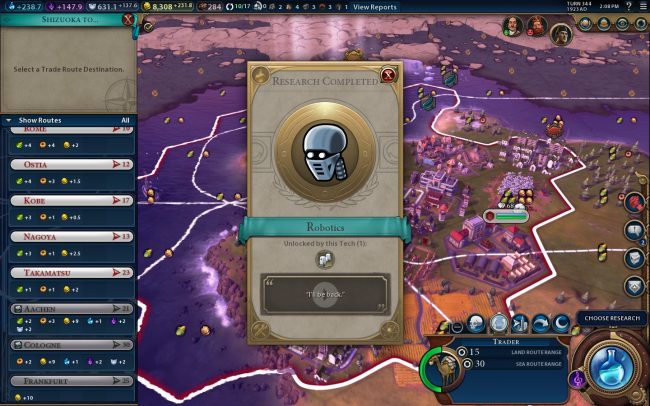
… Okay, just one more, I promise. I can’t not talk about Sean Bean, right? Yeah, if you didn’t know, Sean Bean is the new narrator. When you research a new tech, there he is, not dead, talking in his gruff Scottish accent like a true manly man. As a friend of mine put it, “It’s not that great, but I’ll never get sick of it,” which is because it’s Sean mothertuckin’ Bean. Far from his best work, perhaps, but a lovely voice to have around? Most certainly. His accent always left a smile on my face, either because I’m an asshole or because he was having a great time recording some of these quotes. Probably me. I did nuke the Nords quite thoroughly… But Sean Bean!
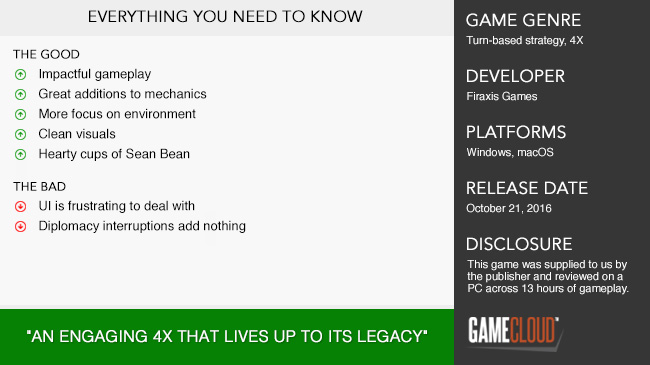
Fresh mechanics make Civ VI more enjoyable to play than its predecessors, which is saying a hell of a lot for a 4X game. There are still some niggly issues, but nothing that ruins the game to the point where you’d have preferred buying a chimpanzee with a love of razor wire. The addition of tech boosts, districts, amenities, expendable workers, and so much more make this, arguably, one of the finest Civ games to date. If I had more free time, I’d play the game a lot more, but if I start again, no one would hear from me for weeks. Still, one more turn couldn’t hurt…











